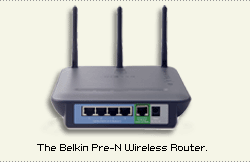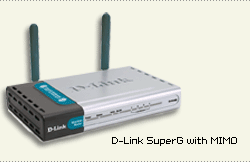
This story appeared on Network World Fusion at
http://www.nwfusion.com/net.worker/news/2005/020705netlead.html


![]()
This story appeared on Network World Fusion at
http://www.nwfusion.com/net.worker/news/2005/020705netlead.html
Vendors all tout extended range and performance, but competing technologies cause a dust-up.
Think of the wireless LAN industry as a band of pilgrims en route to Canterbury. But because the path is long and arduous, discord arises, and smaller groups break off to have adventures and make some money along the way.
Also: 802.11n update: TGn Sync vs WWiSE
Of course, the Promised Land is 802.11n , the IEEE WLAN specification that will provide 100M bit/sec-plus data throughput rates. But because ratification of the spec isn't expected until late 2006, vendors have begun offering products with enhanced speed, range and coverage using a mix of proprietary technologies.
In December, Belkin began offering what it's calling "pre-N" routers and adapters. Linksys, Netgear and D-Link have since announced multiple-input/multiple-output (MIMO )-based products; and Buffalo Technology, SMC Networks and Actiontec have similar plans in motion.
[an error occurred while processing this directive]In one sense, this is good news for small offices and consumers whose current wireless networks fall short, and for early adopters experimenting with network media adapters and Media PCs to stream content between TVs, stereos and PCs. The products all tout double (or more) the throughput and range of today's standards-based 802.11g and 802.11a products, which makes them suitable (at least in theory) to carry multiple streams of high-definition television.
But in another, the rejection of standards turns the WLAN industry on its head, which for several years has enjoyed enormous growth partly because of its adherence to standards and insistence on interoperability.
The new MIMO market breaks down into three camps: Belkin and Linksys offer MIMO gear based on Airgo's chipset; Netgear has partnered with smart antenna vendor Video54 and plans to ship gear this spring; D-Link (and soon SMC) is using Atheros' new Super G with MIMO chipset in products available now.
In a general sense, MIMO uses multiple antennas and radios in the same frequency to transmit data, and is the basis for the 802.11n spec.
Airgo's CEO Greg Raleigh, who wrote the first academic paper on MIMO in 1996 at Stamford and has 26 patents in the field, says "True MIMO" (a term Airgo has patented) requires not only multiple antennas and radios on both the transmit and receive sides of the link but also the ability to do spacial multiplexing. Spacial multiplexing allows for the transmission of multiple distinct datastreams over multiple radios in the same band at the same time, effectively doubling (or tripling) data throughput. Think of it as sipping milk through two (or more) straws at once.
Specifically, Airgo's MIMO chipset transmits two distinct datastreams simultaneously at 54M bit/sec to yield 108M bit/sec. Linksys, which uses the Airgo chip in its new Wireless-G Broadband Router with SRX, says it gets about 40M bit/sec actual throughput.
 However,
Atheros, and Netgear with Video54, are pushing to broaden the
definition of MIMO to not require spacial multiplexing. Atheros CEO
Craig Barratt says, "Our position is that MIMO is any system that has
multiple antennas at both ends of the link being used concurrently. How
you actually use them is subject to various choices in implementation."
However,
Atheros, and Netgear with Video54, are pushing to broaden the
definition of MIMO to not require spacial multiplexing. Atheros CEO
Craig Barratt says, "Our position is that MIMO is any system that has
multiple antennas at both ends of the link being used concurrently. How
you actually use them is subject to various choices in implementation."
Video54's BeamFlex technology uses seven internal antennas to transmit and receive the same data over multiple paths simultaneously. This strengthens the signal, results in fewer lost packets and errors, and increased performance and distance. But it uses only one radio and one transceiver, and sends only one datastream.
Atheros' new MIMO chipset uses four antennas and two radios, which send data over two transceivers simultaneously and sounds more like Airgo's MIMO. But the two radios transmit the same datastream simultaneously, which isn't spacial multiplexing.
It comes to this: Raleigh argues MIMO is spacial multiplexing. Barratt argues spacial multiplexing is a feature of MIMO.
 "We're
worked up about this because we've worked hard on this technology, and
we feel that it's being pirated," Raleigh says.
"We're
worked up about this because we've worked hard on this technology, and
we feel that it's being pirated," Raleigh says.
But others see the humor:"There's somebody who could be using balloons tomorrow and potentially describe it as MIMO," says Malachy Moynihan, Linksys' vice president of engineering and product marketing.
When shopping, users need to put any assumptions of interoperability aside. Even though Linksys' and Belkin's products use the Airgo chipset, they won't necessarily work together: Linksys says they won't, Belkin says they will.
Although Belkin calls its products pre-N, no vendors claim their MIMO products will interoperate with the final 802.11n spec. Linksys' Moynihan objects to Belkin's use of the term, saying it misleads users into assuming its products will work with final 802.11n gear. Moynihan says he expects Linksys to come out with three distinct MIMO-based iterations between now and 802.11n's ratification, and that each might not be backward-compatible with its predecessor.
Atheros' Barratt says Netgear's Video54 implementation works well with the Atheros Super G with MIMO products. "We think Video54 is a very desirable stepping stone, one that maintains backward compatibility."
 All
the vendors claim their products will improve overall performance in a
mixed 802.11b/g network, even by adding just one new MIMO client or
router. And all seem to agree that products that rely simply on smart
antenna technology, like Netgear's, won't cause network problems.
All
the vendors claim their products will improve overall performance in a
mixed 802.11b/g network, even by adding just one new MIMO client or
router. And all seem to agree that products that rely simply on smart
antenna technology, like Netgear's, won't cause network problems.
However, Airgo rivals insist they've found Airgo products interact poorly in a mixed environment, delivering lower data rates than you'd typically get on a standard-g network. Raleigh says Airgo's products work seamlessly with both 802.11b and 802.11g gear, and adds that the Atheros MIMO chipset is based on the Atheros Super G chipset, which uses channel bonding to reach 108M bit/sec "turbo" speeds. Channel bonding is notoriously disruptive to standard 802.11b/g networks.
[an error occurred while processing this directive]RELATED LINKS
Wireless LAN group takes step toward high-speed standard
The
IEEE 802.11n Task Group last week winnowed out some proposals for a
standard that's intended to boost wireless LAN throughput, not just the
overall data rate, to at least 100M bit/sec.
Network World, 01/21/05
Wireless LAN industry starts raising antennas over MIMO
Wireless
LANs soon will start doubling or more in throughput and range if a
smart antenna technology dubbed MIMO pans out as its backers anticipate.
Network World, 03/08/04
Wireless vendors try defining MIMO
Two
developments last week illustrate the growing frenzy of interest in
adopting a radio technology that promises to boost wireless LAN
throughput from about 20M bit/sec today to at least 100M bit/sec.
Network World, 08/16/04
My oh MIMO
Using multiple transmitters and receivers, new technology offers major boost to wireless LANs.
Network World, 08/30/04
802.11n throttles up WLAN throughput
The
drive for higher throughput in wireless LANs has pushed the IEEE to
develop 802.11n, a new version of the 802.11 standard that promises
throughput in excess of 100M bit/sec in 20-MHz to 40-MHz of bandwidth.
Network World, 11/22/04
D-Link Super G with MIMO
D-Link
Wireless G with SRX
Linksys
Wireless Pre-N Router
Belkin
BeamFlex
Video 54
Antenna Basics (PDF)
Linksys
Q&A: IEEE 802.11n (PDF)
Wi-Fi Alliance
D-Link Super G with MIMO Smart Antenna Technology (PDF)
D-Link
All contents copyright 1995-2003 Network World, Inc. http://www.nwfusion.com